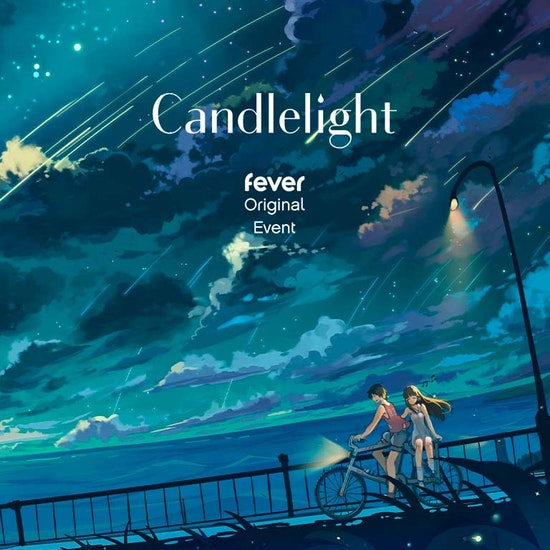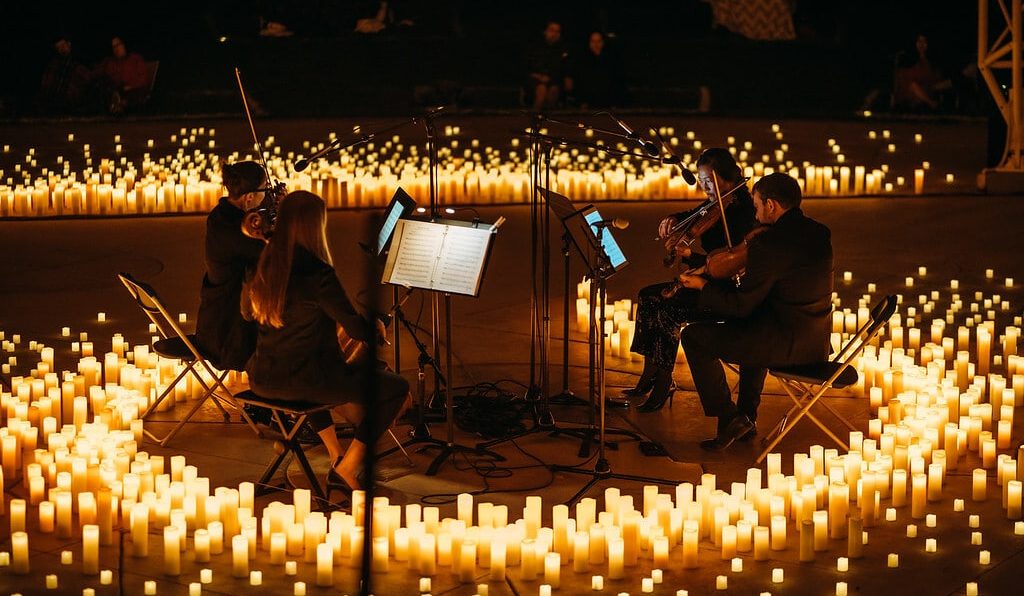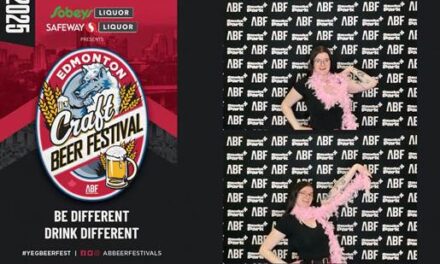
Review by Cassandra Wong
When Syd invited me to attend Candlelight: Best of Anime Soundtracks on October 12, I was rather apprehensive—a performance of Asian media and culture was to be held despite the recent cases of Asian hate crimes due to the pandemic, and to top it all off, late at night?
But Syd seemed so excited for it, so, albeit reluctantly, I agreed to go with her. On October 12, the rustic charm of the Pioneers Cabin, a cozy-looking log cabin that reminded me of crackling hearths and hot chocolates over fluffy blankets and uncontrollable giggles, was accentuated by the soft piano music playing over the speakers in the corner. In the warm glow of the artificial candles, anticipation blanketed the audience as they awaited the second last performance of Candlelight: Best of Anime Soundtracks.
Despite the dark cabin, it was easy to see that there were people of all different backgrounds and ages, all buzzing with excitement for the performance, which was heartening and relieved a large portion of my anxiety regarding Asian hate. In fact, the concert was so popular that tickets had sold out almost immediately. When Syd suggested the event in late September, a quick look at the event site showed that there were only three performances left with just the tiniest amount of available tickets, which were quickly snatched up.
The Candlelight concert series was created by Fever, an international event company that aims to inspire through experience. When one thinks of a music concert, the image of the grand theatre adorned with spotlights and crimson curtains, with the scent of wood lingering in the air, comes to mind. However, the Candlelight concerts, as their name suggests, are held in a smaller, less formal venue with only candlelight—in this case, the Pioneers Cabin—which offers a much more intimate experience of the selected music.
Moreover, the choice in music for the Candlelight concerts range from the classical music from traditional composers that is so often associated with instrumental concerts, to covering an array of genres in pop culture that cater to a wider audience. This evening’s performance spanned about an hour and included 12 pieces of about three to four minutes each (with the performers explaining each piece between songs) from dear and beloved anime series that targeted the childhood nostalgia of watching these series—though here, I would like to disclaim that I have not watched many of the series that the pieces that were played, despite being aware of their popularity.

As the performers walked on stage, the hum of the conversation died down, and the bar in the corner turned off its lights, leaving the cabin only lit by the candles surrounding the Listeso String Quartet. Contrary to most string quartets, the Listeso Music Group classifies themselves as a boutique agency that claims to work with the finest young local performers in the country—but, you might ask, why only young performers? Unfortunately, the agency uses young performers in need of money: they chose to use a string quartet rather than an orchestra or other instruments as string quartets cost much less than the latter options.
Near the end of the program, the performers introduce themselves: Alison Stewart as first violin, Sylvia Chow as second violin, Clayton Leung on the viola, and Amy Nicholson on the cello. The violist was a different person than advertised in the program, but a quick glance at the program tells me that these musicians are quite well-accomplished and capable, so why might they be here, playing music they’re not very enthusiastic about, for less than ideal wage? Perhaps the pandemic has hit the music industry much harder than we could’ve ever imagined, but that, I believe, is a topic for another time.
While I was wondering how they would see the sheet music in such a dimly lit room, they placed iPads on their music stands with the sheet music on the screen. After a brief tuning, they launched into the first haunting notes of Tokyo Ghoul’s opening, “Unravel”. It was such a well known song amongst the anime community that everyone immediately recognized it, and a cheer went up amongst the audience. The song was played beautifully despite the lack of percussion (which plays a key part in most anime openings that are, as people call it now, “bangers”) and I enjoyed how they made use of compounding the sounds of the four instruments to create a similar buildup to the original song.
After “Unravel”, Chow picked up the microphone set on the table between them and provided us a brief introduction to the performance and the song. “This may be the only performance where the audience knows the songs better than we do,” she said, eliciting a round of laughter from the audience.
While it was humorous, the following songs and their introductions did appear rather lackluster, as if the performers had simply Googled “fun facts about” the anime and copy-pasted a paragraph onto their script. I didn’t attend the event expecting the performers to be enamoured with the content, with consideration to how the string quartet was formed, but the severe lack of enthusiasm from the performers—Nicholson said “we really enjoyed playing this song, so I hope you guys enjoy it too” three times—made the experience a little less enjoyable for me.
Following Tokyo Ghoul was a piece from Yuri on Ice, an ice skating anime with a stunning soundtrack. While I had expected them to play the opening to the anime, as they did with every other anime in the program, they chose instead to play a piece that the main character had performed with in the anime—Eros. I suppose with the heavy brass and percussion instrumentation, it would have been difficult to perform the opening with a string quartet.
The program continued with Evangelion, Naruto and Inuyasha. I particularly liked the fact that they chose to combine Naruto and Inuyasha because both anime series stemmed from Japanese fox folklore. It was interesting how the order of the pieces were somewhat determined by intensity. After a slower song, the quartet would play a stronger, louder song, and vice versa. It kept the audience on their toes, looking forward to the next piece.
After Inuyasha, the quartet played the openings to Detective Conan and Attack on Titan, the latter of which was such a popular anime (the final season of it will begin releasing early next year) that at the “Sasageyo” part of the song, I saw many audience members singing along and performing the Survey Corps salute from the anime. Following an iconic piece with another, the quartet played pieces from Full Metal Alchemist and Sailor Moon, both older anime series that were incredibly well known—to the point where even people who aren’t interested in anime are aware of, and often use, images of characters from these series. Up until this point, the two violins were the focal point of most of the pieces, so when the viola became the main focus during the Sailor Moon opening, I was pleasantly surprised.
The quartet then brought us back to more modern anime series with the openings to Death Note and Elfen Lied, then took us way back with Dragon Ball. When introducing Dragon Ball, Nicholson mentioned that it was heavily inspired by the Hong Kong Kungfu scene, which made me curious to see how the string quartet would play a song with such heavy Asian instrumentals. They started the piece with a bang by stomping their feet on the stage, which jolted the audience and was the only form of percussion I saw that night. It was a creative way to bring back audience members that had drifted since the beginning of the performance.
Jojo’s Bizarre Adventures, Cardcaptor Sakura (the introduction of which Syd and I were slightly taken aback by as the performer mispronounced Sakura—as it was such a beloved childhood anime for both of us) and Your Name were then featured. Because Your Name was a movie and not a series of episodes, there was no opening song to it—instead, the quartet chose to play Sparkle, a piece that was used multiple times during key moments in the film. The song, like its name, was stunning and listening to the string quartet play the piece brought tears to my eyes again, as if I was watching the film once more.
They finished the night off with a Studio Ghibli melody (again, there was a confusion with the pronunciation of Ghibli, which was slightly offputting) that included the soundtracks from Howl’s Moving Castle and My Neighbor Totoro. It felt as if they had sent me back in time, sitting criss-cross apple-sauce in front of the television with wide eyes and a bag of chips, watching the film over and over again as my aunt told me to finish my homework.
Despite the program being subject to change, I was really looking forward to the string quartet’s rendition of My Neighbor Totoro, better known as Demon Slayer. The set list appeared to be predominantly older, “classic” anime series, so I was curious to see how the crowd would receive a newer anime piece. Unfortunately, the piece was not played that night and I could not make that observation.
But overall, I thoroughly enjoyed the live instrumental music, which I don’t get to hear often, especially songs I’m familiar with. Syd agreed that while she appreciated the honesty, the lack of knowledge regarding the background of the pieces did dull the mood a bit for her. She also liked the pairing of the songs and the engagement with the audience—altogether, she also had a wonderful time that night.
While I am not likely going to attend similar events featuring the Listeso Music Group in the future, I do look forward to the development of instrumental performances of anime music and how that will change the music performance industry.
Fever Candlelight Concerts webpage


